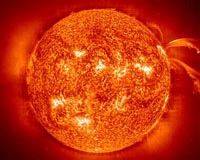 |
Washington DC (SPX) Mar 1, 2011 NASA will host a media teleconference at 1 p.m. EST on Thursday, March 3, to discuss the first computer model that explains the recent period of decreased solar activity during the Sun's 11-year cycle. The recent solar minimum, a period characterized by a lower frequency of sunspots and solar storms, ended in 2008 and was the deepest observed in almost 100 years. Teleconference panelists: * Richard Fisher, director, Heliophysics Division, Science Mission Directorate, NASA Headquarters, Washington * Dibyendu Nandi, assistant professor, Indian Institute of Science Education and Research, Kolkata, India * Andres Munoz-Jaramillo, visiting research fellow, Harvard-Smithsonian Center for Astrophysics, Cambridge, Mass. * Delores Knipp, visiting scientist, University of Colorado at Boulder To participate in the teleconference, reporters must contact Trent Perrotto at +1 202-358-0321 or [email protected] by 10 a.m. EST on March 3 for dial-in instructions. Requests must include media affiliation and telephone number. Audio of the teleconference will be streamed live on the Web:
earlier related report A potent solar storm could disrupt these technologies, scorch satellites, crash stock markets and cause power outages that last weeks or months, experts said Saturday at the American Association for the Advancement of Science's annual meeting. The situation will only get more dire because the solar cycle is heading into a period of more intense activity in the coming 11 years. "This is not a matter of if, it is simply a matter of when and how big," said National Oceanic and Atmospheric Administration administrator Jane Lubchenco. "The last time we had a maximum in the solar cycle, about 10 years ago, the world was a very different place. Cell phones are now ubiquitous; they were certainly around (before) but we didn't rely on them for so many different things," she said. "Many things that we take for granted today are so much more prone to the process of space weather than was the case in the last solar maximum." The experts admitted that currently, little that can be done to predict such a storm, much less shield the world's electrical grid by doing anything other shutting off power to some of the vulnerable areas until the danger passes. "Please don't panic," said Stephan Lechner, director of the European Commission Joint Research Center, drawing laughter from the scientists and journalists in the audience. "Overreaction will make the situation worse." The root of the world's vulnerability in the modern age is global positioning systems, or GPS devices, that provide navigational help but also serve as time synchronizers for computer networks and electronic equipment, he said. "GPS helped and created a new dependency," said Lechner, noting that the technology's influence extends to aerospace and defense, digital broadcast, financial services and government agencies. In Europe alone, there are 200 separate telecommunication operators, and "nothing is standardized," he said. "We are far from understanding all the implications here," he said. World governments are hurrying to work on strategies for cooperation and information sharing ahead of the next anticipated storm, though forecasters admit they are not sure when that may occur. "Actually we cannot tell if there is going to be a big storm six months from now but we can tell when conditions are ripe for a storm to take place," said the European Space Agency's Juha-Pekka Luntama. On Tuesday at 0156 GMT, a huge solar eruption, the strongest in about five years, sent a torrent of charged plasma particles hurtling toward the Earth at a speed of 560 miles (900 kilometers) per second. The force of the Class X flash, the most powerful of all solar events, lit up auroras and disrupted some radio communications, but the effects were largely confined to the northern latitudes. "Actually it turned out that we were well protected this time. The magnetic fields were aligned parallel so not much happened," said Luntama. "In another case things might have been different." Space storms are not new. The first major solar flare was recorded by British astronomer Richard Carrington in 1859. Other solar geomagnetic storms have been observed in recent decades. One huge solar flare in 1972 cut off long-distance telephone communication in the midwestern state of Illinois, NASA said. Another similar flare in 1989 "provoked geomagnetic storms that disrupted electric power transmission" and caused blackouts across the Canadian province of Quebec, the US space agency said. A panel of NASA-assembled scientists issued a report in 2009 that said a powerful solar flare could overwhelm high-voltage transformers with electrical currents and short-circuit energy grids. Such a catastrophic event could cost the United States alone up to two trillion dollars in repairs in the first year - and it could take up to 10 years to fully recover, the report said.
Share This Article With Planet Earth
Related Links Sun and Earth at NASA Solar Science News at SpaceDaily
 Solar Experts Detect Waves In Giant Magnetic Holes The Size Of The UK
Solar Experts Detect Waves In Giant Magnetic Holes The Size Of The UKSheffield, UK (SPX) Feb 25, 2011 Massive waves in giant magnetic holes on the surface of the Sun have been discovered for the first time by solar scientists from the University of Sheffield and Queen's University Belfast, something that will bring experts a step closer to unlocking the secrets of the Sun. The Sun is interwoven by a complex network of magnetic field lines that are responsible for a large variety of fascina ... read more |
|
| The content herein, unless otherwise known to be public domain, are Copyright 1995-2010 - SpaceDaily. AFP and UPI Wire Stories are copyright Agence France-Presse and United Press International. ESA Portal Reports are copyright European Space Agency. All NASA sourced material is public domain. Additional copyrights may apply in whole or part to other bona fide parties. Advertising does not imply endorsement,agreement or approval of any opinions, statements or information provided by SpaceDaily on any Web page published or hosted by SpaceDaily. Privacy Statement |